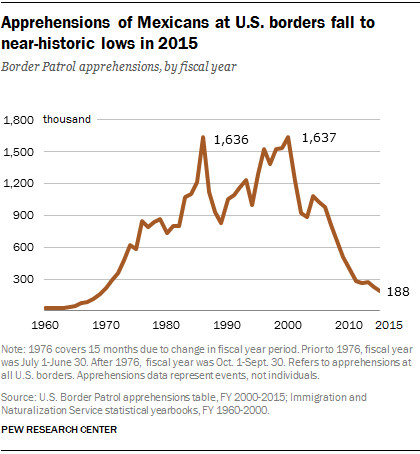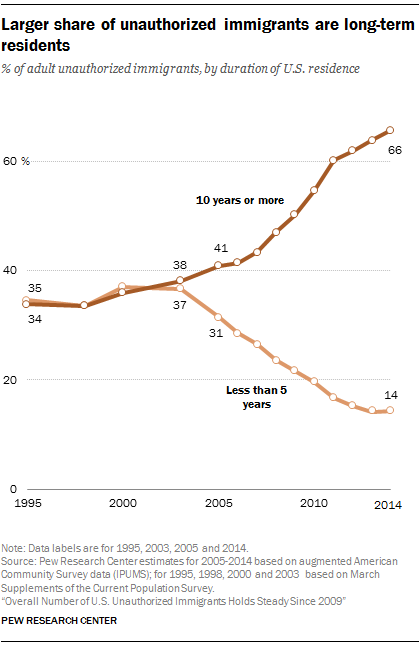
7 facts on immigration that every American should know
1: The era of undocumented Mexican migration is over.
Undocumented immigration from Mexico is at near historic lows, according to United States Border Patrol data. In fact, more Mexicans are leaving the U.S. than are arriving, and net migration from Mexico has fallen to zero.
Undocumented migration from Mexico decreased because of a confluence of factors on both sides of the border, including a decline in jobs in the U.S. coupled with Mexico’s demographic transition. While the share of undocumented immigrants from Mexico has declined, the share of immigrants from Asia, Central America and sub-Saharan Africa has increased.
2. Border walls can have unintended effects, such as caging people in rather than keeping people out.

Doug Massey, a sociologist at Princeton University and expert in undocumented migration and border enforcement, and his colleagues argue that U.S. “border enforcement has backfired as a strategy of immigration control.” Historically, undocumented Mexican workers engaged in a pattern of circular migration between the U.S. and Mexico. A large body of research shows that increased border enforcement has made it more costly and dangerous to cross, leading to longer stays, the dispersal of undocumented migrants into all 50 states, and family settlement in the U.S.
Just over 11 million undocumented immigrants reside in the U.S. Between 2009 and 2013, about 4 million undocumented people lived with children under the age of 18. According to the Migration Policy Institute, 84 percent of these 4 million undocumented immigrants lived with at least one U.S. citizen child, demonstrating that many undocumented people are strongly linked to American citizens.
3. The majority of unauthorized immigrants in the U.S. are long-settled and integrated into communities.
According to the Pew Hispanic Center, 66 percent of unauthorized adults in the U.S. in 2014 have been living in the country for at least a decade. Only 14 percent of unauthorized immigrants had been in the country five years or less.
More than half of California’s undocumented immigrants have lived in the U.S. 10 years or longer. As Manuel Pastor and Enrico Marcelli demonstrate, these long-settled unauthorized immigrants comprise a variety of people including parents, children, teenagers, workers, homeowners, and business owners. They are integrated into our communities, the labor-market market, schools and civil society.
4: Rescinding Deferred Action for Childhood Arrivals (DACA) — or allowing it to expire — will have devastating impacts on families, weaken communities and drain hundreds of billions of dollars from our Gross Domestic Product (GDP).
DACA has provided temporary relief from deportation along with work authorization for more than 700,000 young people brought to the U.S. as children. DACA recipients have translated their status into positive economic, social, civic and educational outcomes that ultimately benefit families, communities and the nation. The Center for American Progress estimates that ending DACA would eliminate $433.4 billion in GDP over a decade.
5: The majority of Americans do not support a border wall, but they do support immigration reform with a pathway to citizenship.

According to a recent survey conducted by Pew Research Center, only 39 percent of people view building a wall along the U.S.-Mexico border as “somewhat important” or “very important.” In contrast, a majority of Americans (62 percent) support immigration reform with a pathway to citizenship for America’s long-settled undocumented population.
6: Immigration, even if undocumented, is associated with lower crime rates in communities and cities, and immigrants are less likely to commit crimes compared to the native-born.
Harvard sociologist Robert Sampson’s study of police records and census data found that cities of concentrated immigration are some of the safest cities in the United States. Recent research also demonstrates that “crime is statistically significantly lower in sanctuary counties compared to nonsanctuary counties.” These larger patterns are reflected in incarceration rates, as immigrants, including Mexican immigrants, are less likely to commit crimes and be incarcerated than the native-born.
7: The majority of Americans are against banning Syrian refugees and Muslims from entering the country.
A 2016 PRRI/Brookings Survey Report examining the public’s attitudes towards terrorism found that 58 percent of Americans oppose banning Muslims from entering the U.S. and 55 percent oppose banning Syrian refugees.
In all, data and research provide critical insights for current debates. First, building another wall along our southern border is at odds with the reality of decreasing undocumented migration from Mexico. Second, the majority of Americans support comprehensive immigration reform that includes a pathway to citizenship for undocumented immigrants. Third, rescinding DACA — or letting it expire — will devastate families, weaken our communities and have significant negative impacts on our economy. Fourth, a large body of research demonstrates an inverse relationship between immigration and crime. And finally, the majority of Americans see the country as one that is inclusive rather than exclusive and insular. These are facts worth remembering.
Jody Vallejo is associate professor of sociology and American studies and ethnicity, and associate director of CSII. Carolyn Choi is a Ph.D. candidate in sociology at USC Dornsife. This article first appeared on the CSII blog.